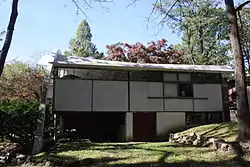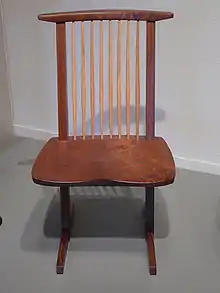George Nakashima House, Studio and Workshop
The George Nakashima House, Studio and Workshop is a historic artist's compound at 1847 and 1858 Aquetong Rd. in Solebury Township, Bucks County, Pennsylvania. The compound consists of houses and studio buildings designed and built by artist George Nakashima (1905-1990), which served as family homes and as his studio space. The studio-related buildings are open to the public for tours; the houses of the compound continue to serve as residences of the Nakashima family. In April 2014 it was also designated a National Historic Landmark.[3] The site was listed on the World Monument Fund's 2014 Endangered Sites Watchlist.[4][5]
George Nakashima House, Studio and Workshop | |
 Conoid Studio | |
  | |
| Location | 1847 and 1858 Aquetong Rd., Solebury Township, Pennsylvania |
|---|---|
| Coordinates | 40°20′24.7″N 74°57′20.1″W |
| Area | 12.2 acres (4.9 ha)[1] |
| NRHP reference No. | 08000782[2] |
| Significant dates | |
| Added to NRHP | August 14, 2008[2] |
| Designated NHL | April 23, 2014 |
Description
The Nakashima complex is located in a rural setting south of the town of New Hope, Pennsylvania, on both sides of Aquetong Road south of Windy Bush Road in Solebury Township. The property consists of more than 12 acres (4.9 ha), set near the top of a south-facing hillside. The compound includes a total of eighteen buildings, seven of which are primarily residential in nature, while the others serve roles in the production and distribution of Nakashima's furniture and art. Four of the residential structures, located on the north side of Aquetong Road, form a complex Nakashima built for his daughter Mira, and are not open to the public. On the south side of the road, surrounded on three sides by studio buildings, is a residential compound consisting of the main house, a garage, heating house, and lanai. All of these buildings are in a basically International Style of architecture, infused with Japanese elements.[1]
The main buildings of the studio are the Conoid Studio and the Arts Building. The Conoid Building, which Nakashima built in 1960, is a distinctive rectangular single-story building with a concrete roof in the shape of a sinusoidal wave that gradually flattens toward the south. The walls are fashioned out of a variety of materials, including stone, concrete, cement blocks, and glass. The roof form gives the building interior a large open area, with sections carved out by wood framing for kitchen, bathrooms, and an office. The Arts Building was built by Nakashima in 1967 as a gallery space to showcase the works of Ben Shahn. It is 2-1/2 stories in height, and is topped by a parabolic roof formed out of plywood and covered in asphalt shingles. It now also displays works of Nakashima.[1]
Eight buildings of the complex are open for tours; donations are requested.
Gallery
 Showroom.
Showroom. Finishing Department.
Finishing Department. Arts Building.
Arts Building. Studio.
Studio. Conoid Chair by George Nakashima
Conoid Chair by George Nakashima
See also
References
- David Kimmerly (November 2007). "National Register of Historic Places Registration: George Nakashima House, Studio and Workshop" (pdf). National Park Service. Cite journal requires
|journal=(help) (58 pages including 9 photos and several maps and diagrams) - "Announcements and actions on properties for the National Register of Historic Places, August 22, 2008". New listings. National Park Service. Retrieved 2008-08-25.
- Litterst, Mike (23 April 2014). "Interior Designates Four New National Historic Landmarks to Honor Nation's Unique Cultural Heritage & History" (Press release). National Park Service. Retrieved 28 April 2014.
- World Monuments Fund. "George Nakashima House, Studio and Workshop". Current Watch Site. Retrieved November 14, 2013.
- Ebeling, Ashlea. "World Monuments Fund Names Endangered Sites foe 2014, Including Nakashima's Studio". Forbes Magazine. Retrieved November 14, 2013.
External links
| Wikimedia Commons has media related to George Nakashima House. |
- George Nakashima Woodworker
- George Nakashima Studio, a Flickr photoset
- George Nakashima bench on Antiques Roadshow
- Meet America's Newest Historic Landmarks, PBS Newshour, April 27, 2014.
- Historic American Buildings Survey (HABS) No. PA-6783, "George Nakashima Woodworker, 1847 Aquetong Road, New Hope, Bucks County, PA", 8 photos, 1 color transparency, 1 photo caption page
- HABS No. PA-6783-A, "George Nakashima Woodworker, George Nakashima House, 1847 Aquetong Road, New Hope, Bucks County, PA", 4 photos, 1 color transparency, 1 photo caption page
- HABS No. PA-6783-B, "George Nakashima Woodworker, Workshop, 1847 Aquetong Road, New Hope, Bucks County, PA", 14 photos, 1 photo caption page
- HABS No. PA-6783-C, "George Nakashima Woodworker, Showroom, 1847 Aquetong Road, New Hope, Bucks County, PA", 4 photos, 1 photo caption page
- HABS No. PA-6783-D, "George Nakashima Woodworker, Conoid Studio, 1847 Aquetong Road, New Hope, Bucks County, PA", 6 photos, 1 photo caption page
- HABS No. PA-6783-E, "George Nakashima Woodworker, Arts Building, 1847 Aquetong Road, New Hope, Bucks County, PA", 11 photos, 2 color transparencies, 1 photo caption page
- HABS No. PA-6783-F, "George Nakashima Woodworker, Reception House, 1847 Aquetong Road, New Hope, Bucks County, PA", 4 photos, 1 color transparency, 1 photo caption page
- HABS No. PA-6783-G, "George Nakashima Woodworker, Finishing Department, 1847 Aquetong Road, New Hope, Bucks County, PA", 3 photos, 1 photo caption page
- HABS No. PA-6783-H, "George Nakashima Woodworker, Chair Department, 1847 Aquetong Road, New Hope, Bucks County, PA", 3 photos, 1 photo caption page
- HABS No. PA-6783-I, "George Nakashima Woodworker, Main Lumber Storage, 1847 Aquetong Road, New Hope, Bucks County, PA", 1 photo, 1 photo caption page
- HABS No. PA-6783-J, "George Nakashima Woodworker, Pool House and Swimming Pool, 1847 Aquetong Road, New Hope, Bucks County, PA", 1 photo, 1 photo caption page
- HABS No. PA-6783-K, "George Nakashima Woodworker, Garage, 1847 Aquetong Road, New Hope, Bucks County, PA", 1 photo, 1 photo caption page
- HABS No. PA-6783-L, "George Nakashima Woodworker, Pole Barn, 1847 Aquetong Road, New Hope, Bucks County, PA", 3 photos, 1 photo caption page

